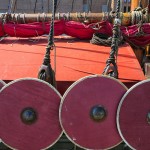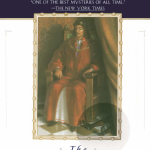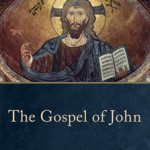Many years ago now I picked up David Drake’s epic fantasy Lord of the Isles, and was enchanted. The book seemed fresh, and delightfully different from the other fantasy novels I was reading at the time. It was the first in a series, and I read each volume as it came out…until, seven or eight years ago, it was announced that the final novel on the series, The Crown of the Isles, would be published in three volumes. At that point I decided to wait until all three were available, and then I forgot all about it. The series is complete now, though, and has been since (I think) 2008, and so a month or so ago I decided to finish it up, reading the whole saga from start to end.
The series concerns the Kingdom of the Isles, a land consisting of a roughly circular archipelago of quite large islands. Within the circle of the Isles lies the Inner Sea; without, the Outer Sea; and if there are any other land masses, they never come to our attention. The civilization is that of the ancient peoples of the Mediterranean; the religion is roughly Sumerian, based on the worship of the Shepherd, the Lady, and the Sister who rules the underworld.
In Drake’s cosmos (which, we will discover, encompasses much more than just the world of the Isles), magic waxes and wanes every 1,000 years. At each thousand year peak, a peak that rises quite sharply, simple hedge-wizards become great and powerful, and more powerful wizards become almost god-like. But power isn’t everything, as Drake frequently reminds us, and though power rises sharply every 1,000 years understanding utterly fails to keep pace.
In short, every thousand years powers will arise who want to dominate the Isles with their magic; and not only are they powerful enough to attempt it, they are also powerful enough to inadvertantly destroy the civilization of the Isles forever, and possibly the entire cosmos with it.
At the previous 1,000-year peak, Carus, King of the Isles, was on the verge of truly uniting the Isles in one kingdom when he and the whole shebang was brought down by the machinations of the Duke of Yole and his pet wizard. Carus and his entire fleet was drowned; but the island of Yole was drowned with him, and the kingdom splintered into warring pieces. Tenoctris, a well-studied but not very powerful wizard of Carus’ day, is on Yole when the disaster occurs; and there at the peak she has just enough magic to save herself. Thrown through time, she washes ashore on the beach of the Isle of Haft—capitol of the Isles in Carus’ day, now a neglected backwater—a thousand years later (of course). As our story begins the Isles still haven’t reattained the level of Carus’ day. And the power of magic is beginning to rise again.
Enter four unlikely heroes, childhood friends from the little village of Barca’s Hamlet: Garric, lineal descendant of Carus. His sister, Sharina. Cashel the shepherd. Ilna, the weaver. These four are central to the future of the Isles. If disaster is prevented, it will be prevented through their efforts. There are those who will attempt to use them, who think them pawns in the Great Game…but not every piece is a pawn, and not every person is what they seem.
Each volume of the series brings a new challenger and new challenges to be overcome by our four heroes, with the wisdom and aid of Tenoctris. After the third book, the pattern becomes obvious: Garric is trying to reunite the Isles, and his friends are helping. Magical forces separate them, often taking them individually to different worlds. They use all of their courage and resourcefulness to persevere, and ultimately are rejoined in a huge climax in which the villain or villains of the current book are conclusively defeated, and all is good—until the next threat arises. And there will be another threat; that’s given by the premise of the series.
There’s a lot to like about the series, especially from a Catholic point of view, because it’s essentially about virtue. The villains use their millennial power to try to achieve their selfish aims. Our heroes don’t have the knowledge, or the vast magical power, but they know who they are, they know what’s right, and they’ll do it or die trying. The essence of our heroes isn’t that they are awesomely bodacious and go off and bend everyone to their will; the essence of our heroes is that they stand fast under adversity. They persevere. They determine the next thing to be done, and they do it. Each of the four represents a different cluster of virtues: Garric is courage, but also prudence and gentleness. Guided by the spirit of Carus, his ancestor, he becomes a mighty warrior; but avoiding the rashness of his ancestor he is able to draw people together rather than simply beheading those who annoy him. Sharina is grace and perseverence. Ilna is justice and duty. And Cashel—I like Cashel a whole lot—is fortitude, and strength, and steadfastness. Cashel is like the immovable object and the irresistable force combined into one person, and if he isn’t exactly bright, he knows what he needs to know.
The episodes and villains are interesting, and for all of the air of realpolitik and intrigue there’s a strong whiff of Faery about the Drake’s wider cosmos. It’s a place that’s much bigger than the bit we see, and it’s clear that there are players whose very existence we can only infer. Our heroes spend a lot of their time having adventures far from the fields we know, and there are always more of them. And that’s OK.
So much for the good; now for the bad, or at least the annoying.
First, the narrative is extremely choppy in the later books of the series. Drake’s concept frequently has the four main characters operating separately, and of course he has to go back and forth. The trouble is, the segments are too short: he goes back and forth way too often. Just as I am getting into Cashel’s storyline, just as I want to see what happens next, Drake jumps back to Ilna, or to Sharina, or to Garric, and I have to switch contexts and remember what’s going on with them, and frankly, it was often more tempting to go look at Facebook. The last three books were especially bad in this regard, and took me longer to read than they should have.
And then there’s the denouement, the climax of the entire series. I won’t describe it; despite the problems, the series is enjoyable and I don’t want to spoil it. The end state is believable in the context of the series; but Drake doesn’t sell it well enough. It’s as though he got tired and just wanted to get it over with. It’s too abrupt, and some things aren’t explained that really should be.
There are two ways to end a book or a series. You can end right after the climax, woohoo, big splashy ending, and just stop; or you can do what I prefer, and spend some time on the ending, tidying up, making everything neat, and letting us rest in the peace and joy that comes after the final threat is defeated. Yes, finally, they are going to live happily ever after, more or less.; give us a taste of it. Drake clearly tries to do this, but it’s too brief, and too cryptic, to be a satisfying end to such a long series.
So, bottom line: it’s a fun series if you like epic fantasy; I’m glad I read it; but I really wish Drake hadn’t taken a hop on the dismount.
If you like epic fantasy, and you’ve not read this series, try at least the first book, as it stands alone pretty well.












